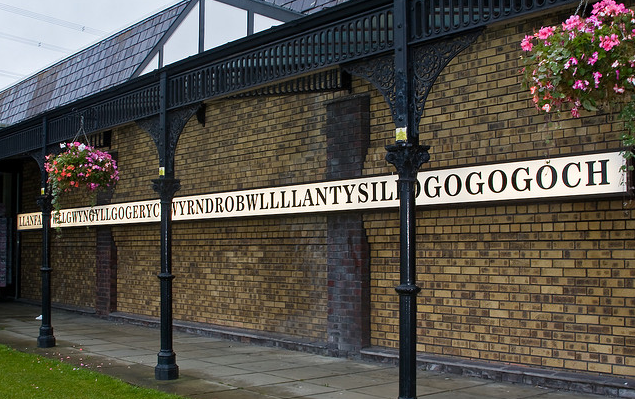Llanfairpwllgwyngyllgogerychwyrndrobwllllantysiliogogogoch is a large village and community on the island of Anglesey in Wales, situated on the Menai Strait next to the Britannia Bridge and across the strait from Bangor. This village has the longest place name in Europe and one of the longest place names in the world. The short form of the village’s name is Llanfairpwllgwyngyll, also spelled Llanfair Pwllgwyngyll. It is commonly known as Llanfair PG or Llanfairpwll.
According to the 2001 census, the population of the community is 3, 040, 76% of whom speak Welsh fluently; the highest percentage of speakers is in the 10–14 age group, where 97.1% are able to speak Welsh. It is the fifth largest settlement on the island by population.
Visitors stop at the railway station to be photographed next to the station sign, visit the nearby Visitors’ Centre, or have ‘passports’ stamped at a local shop. Another tourist attraction is the nearby Marquess of Anglesey’s Column, which at a height of 27 metres (89 ft) offers views over Anglesey and the Menai Strait. Designed by Thomas Harrison, the monument celebrates the heroism of Henry Paget, 1st Marquess of Anglesey at the Battle of Waterloo.
HOW TO SAY THE NAME:
LLAN – FAIR – PWLL – GWYN – GYLL – GO – GER – YCH – WYRN – DROB – WLL – LLAN – TY – SILIO – GO – GO – GOCH
LLAN – To start off with, pronounce this section as you would do the Scottish word “clan”.
Then listen to the sound recording above taking particular notice of how the “ll” is pronounced. It is difficult to explain in words and is more easily learnt by oral example, but we will have a go here anyway. Lie your tongue flat in your mouth so that the tip is firmly touching the bridge behind your front teeth. Keeping the tip of your tongue in place, try and touch your back teeth with the sides of your tongue – now breathe out forcing the air to run strongly over the back of your tongue. This will cause a vibrating noise near your back teeth. Again, keeping the tongue in position, gently change the shape of your tongue until the sound becomes more controlled. This is the “ll” sound you are looking for. Listen to the sound file above and keep on practising.
FAIR – Simply pronounce this section as you would the english word “fire”, (not like you would expect to pronounce the word “fair” in english!) and change the “f” for a “v”.
PWLL – Now you have been practising your “ll” sound this will be a little easier to explain. The “pw” section is pronounced like the “pu” in the english word “put”. Now add the “ll” on the end as described above. Now listen to the sound file again!
GWYN – You may have heard the Welsh name “Gwyn”, well this is pronounced in exactly the same way. Just say the english word “win” and put a “g” in front of it. (pronounce the “g” as you would in the word “gone”). Easy.
GYLL – This is a bit more tricky. First say the english word “gil” (as associated with fish!”). Then change the “l” (as in “let”) to “ll” as explained above. Listen to the sound file again.
GO – Looks easy doesn’t it – it is! Pronounce it as you would the “go” in “gone”
GER – Simply say the word “care” but change the “c” for a “g”.
YCH – Like the pronunciation of “ll”, this is another tricky section to explain. Think of something you don’t like and say “yuck”. Now take the “y” from the beginning to leave “uck”. Now change the “ck” to “ch” as pronounced in the Scottish word “loch”.
WYRN – This looks more complicated that it is. Just say the english word “win”.
DROB – First say the english word “draw” and then add a “b” on the end. Easy.
WLL – You’ve learnt this already. It’s pronounced the same as “pwll” above but without the “p”.
LLAN – Again, this is exactly the same as the “llan” at the beginning of this section.
TY – Simply pronounce this section as you would the “t” in “twig”.
SILIO – Just say “silly – o”. The “o” is pronounced as in “cot”.
GO – As above.
GO – As above.
GOCH – We’re almost there. Simply say “go” as above, put the “ch” after it and that’s it! Put it all together and keep on practising. Now there is only one question remaining …
So, what exactly does it mean?
2010
Source: Wikipedia

